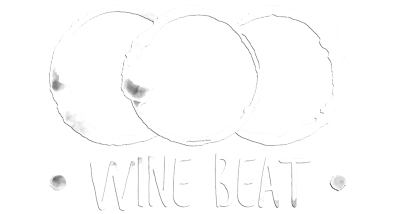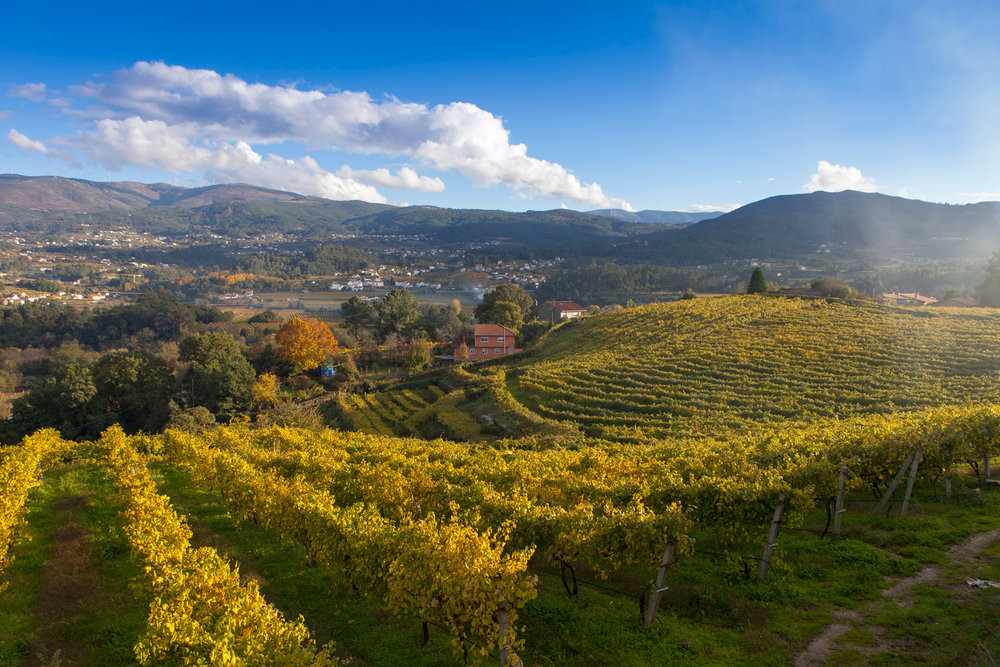 Ireland in Spain some people say. I think it looks just like Rias Baixas.
Ireland in Spain some people say. I think it looks just like Rias Baixas.
Rias Baixas is by no means a new player on the scene. The Albariños of this region have been winning over wine converts in large numbers for a couple of decades now. Still, it seems to me that Rias Baixas continues to maintain a slightly exotic and mysterious reputation. Maybe it has something to do with the name, a name that immediately looks like it will be a tongue twister (pronounced “REE-ahs BI-shas” – once you’ve practiced a time or two it becomes quite fun to say). In fact, Rias Baixas does have a distinctly other-worldly atmosphere. Located up on the north-west coast of the Iberian peninsula, Rias Baixas is nothing like the mountainous and dry interior or the long, curving Mediterranean coastal beaches that many of us picture in our minds when we think about Spain. Rias Baixas is much more like the north-eastern maritime states and provinces of the US and Canada or the coast of Ireland or Scotland. This is a land where the coastline is rugged and battered by the Atlantic Ocean and where people make a living as much from fishing fleets as from agriculture. Rias Baixas is part of Galicia and that means the people have a fiercely independent streak, with their own distinct language and culture. The Gallegos (as they call themselves) are tough people, reflecting their agricultural and seafaring environment. But they are warm and gregarious once they get to know you. Plus they have the best seafood in Spain.
The wines of Rias Baixas, like the people and the land itself, occupy their own very particular place in the world. Agriculture here, including grape-growing, is never far from the sea so everything in the region is somehow shaped by the maritime influence. The Albariño grape dominates and is grown on a trellis system that uses, for its raw materials, that very Galician raw material – granite. With granite posts and granite walls and wide spacing between rows, the trellises are designed to let air move as freely as possible. This helps to control disease (mould and mildew) from the wet conditions. The Gallegos will tell you that they call Galicia “Galifornia” because of the sunny, hot summers and the beaches – but this place isn’t green and intensely verdant for nothing. In fact there is quite a lot of both things – sun and rain – enough of each to allow the grapes to ripen but also to express their maritime nature. Albariño is a creature of this particular climate and is both shaped by the environment and also reflects some of its chief characteristics. We’ll talk more about the salinity of Albariño wine, for example, later.
Where is Rias Baixas?
Galicia occupies that large portion of Spain north of Portugal and the Rias Baixas wine region is located immediately across the Portuguese border. The coastline is marked by dramatic, shallow fjords (“rías”) that drive deeply inland like the tines of a fork . These fjords and the large rivers that empty into them provide the singular habitat for our friend the Albariño grape. There are 5 wine producing subregions within the Rias Baixas DO:
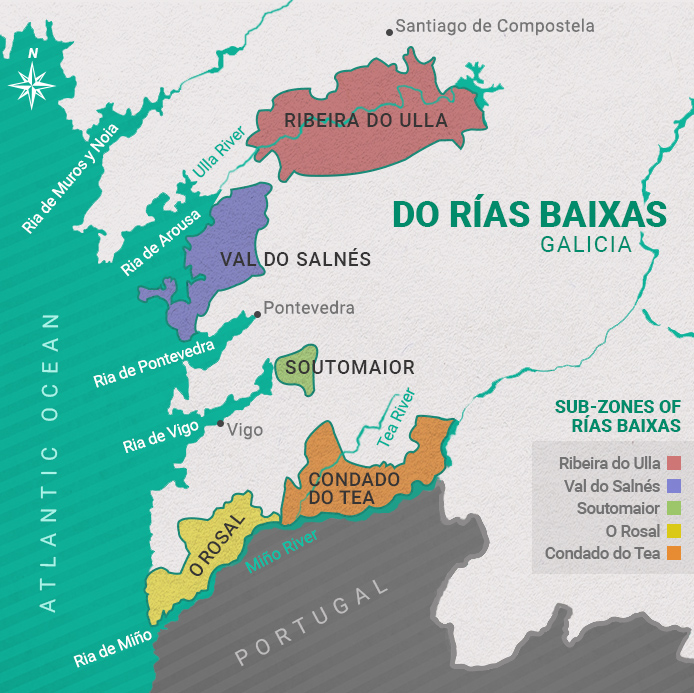
1. Val do Salnés – the oldest wine growing region and one that perhaps best exemplifies the region. This is apparently the original home of Albariño.
2. Soutomaior – the smallest subregion and located at the end of the Rías Vigo.
3. O Rosal – is located on the border with Portugal, with terraces along the Rías Miño. The wine here are often blends of Albariño, Lourero and Caiño.
4. Condado do Tea – also located along the Miño, this subregion is warmer and drier which gives a distinct nature to the wines.
5. Ribeira do Ulla – this is the newest area and is the largest geographically. The soils here are quite distinct and are alluvial as compared to the hard granites of the other regions.
Why Rias Baixas for Wine?
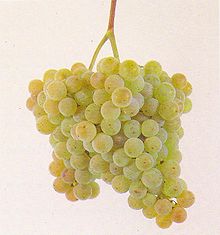
Albariño grapes and Rias Baixas are inseparable
In Rias Baixas it’s all about the Albariño wine. This is one of the most thrilling white wines on the planet. It has a clean, fresh and bright nature that is as piercing as the sun on the Galician coast. It reflects the physical and rough character of the region with the famous salinity (saltiness) on the palate as well as a pronounced mineral note. Then there is the complexity of the fruit characters with lemon/citrus plus often pronounced grapefruit pith bitter touches. What you will also notice is the aromatic nature of the wine – and you might think about Riesling or Grüner Veltliner. This brings up an interesting debate. While the Gallegos are clear in their minds that Albariño is a truly indigenous local grape there is also a school of thought that it is a descendent of Riesling. The words “Alba” and “riño” corresponding roughly, perhaps, to the “banks of the Rhine” river. Certainly both the grapes and the wines bear similarities. But I’ve said too much and am likely to get myself into trouble.
Suffice it to say that Albariño is one of the most attractive white wines. It pairs extremely well with seafood and is complex enough for the connoisseur. You will love how fresh and vivid it is, and how it develops and evolves in the glass. Of course the best place to drink the wine is in its home region. Travel to Rias Baixas and drink the wines in their proper environment of rugged cliffs, lush green valleys, foggy inlets and villages clinging to the shorelines. Eat some of the world’s best seafood on a harbour front as you drink one of the world’s best white wines. And follow the coastline to see the beaches, the fjords, the fishing villages and the very unique Gallego culture. You can continue onwards to the wonderful historic city of Santiago de Compostela with its commanding cathedral, the culmination of so many Camino de Santiago pilgrimages.
Who are The Winemakers?
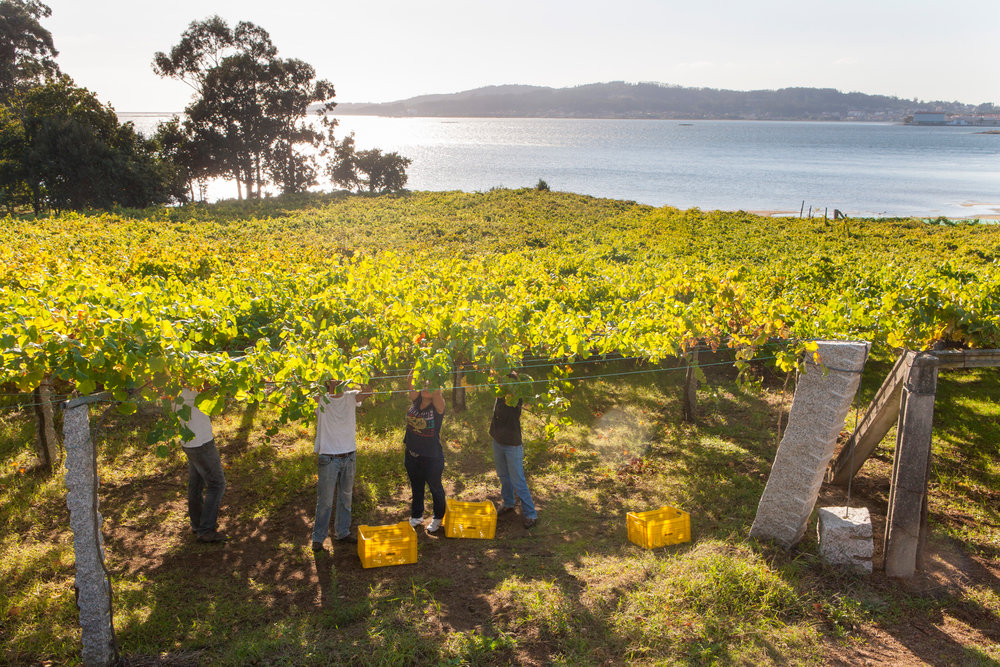 Harvesting Albariño under the famous pergola – hard work on the shoulders!
Harvesting Albariño under the famous pergola – hard work on the shoulders!
There are a large number of winemakers in Rias Baixas and they are producing excellent wines, often at extremely reasonable prices. Check out www.riasbaixaswines.com for a full list of wineries.
When to Visit?
The best time to visit is from late spring to early fall, so anytime from May to October is best. There are many local fiestas (in honour of patron saints in many cases) during the summer months. You can also take in the Fiesta del Albariño in Cambados, Pontevedra in late July/early August and really soak up Albariño wine culture. www.fiestadelalbariño.com
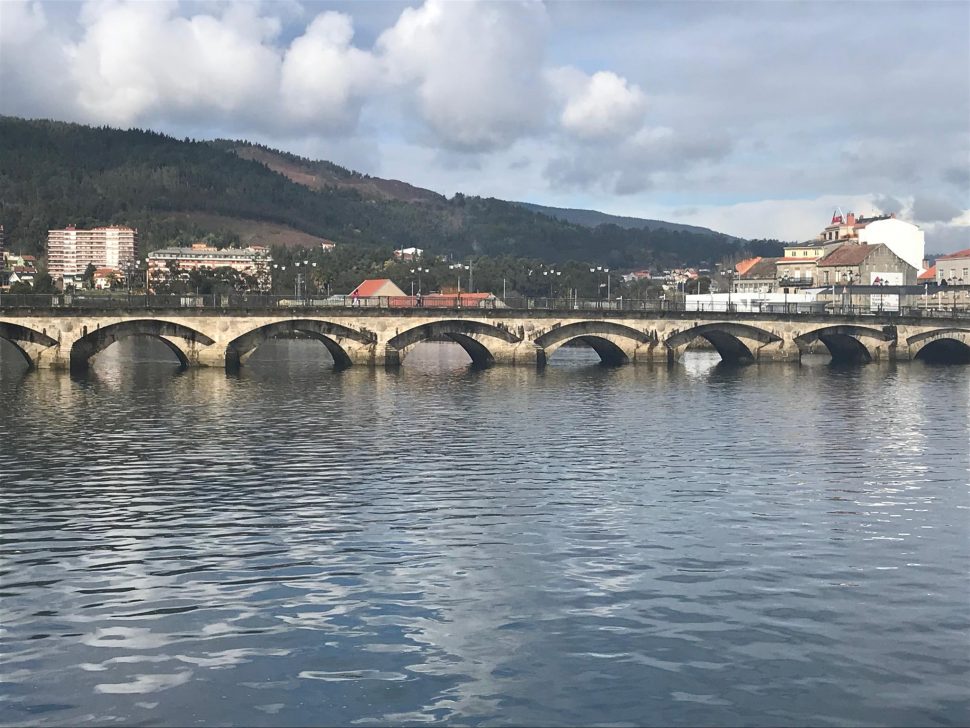 Pontevedra
Pontevedra
Useful Links
 Rias Baixas with its verdant, magical and rugged.coast. Home to the best white wine and seafood combination you might ever find.
Rias Baixas with its verdant, magical and rugged.coast. Home to the best white wine and seafood combination you might ever find.
Photo credits www.riasbaixaswines.com, pixabay and wikipedia
